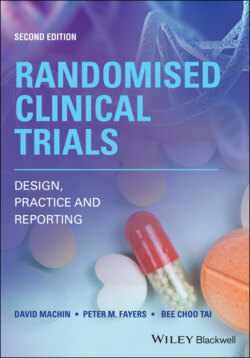Читать книгу Randomised Clinical Trials - David Machin - Страница 31
1.3.3.1 Randomisation
ОглавлениеThe design that provides the strongest type of evidence is the double‐blind (or double‐masked) randomised controlled trial (RCT). In this, the patients are allocated to treatment at random and this ensures that in the long run patients, before treatment commences, will be comparable in the test and standard groups. Clearly, if the important prognostic factors that influence outcome were known, one could match the patients in the standard and test groups in some way. However, the advantage of randomisation is that it balances for unknown and the known prognostic factors and this could not be achieved by matching. Thus, the reason for the attraction of the randomised trial is that it is the only design that can give an absolute certainty that there is no bias in favour of one group compared to another at the start of the trial. Indeed, in Example 1.12, Erbel, Di Mario, Bartunek, et al. (2007), who essentially conducted a single‐arm prospective case study, admitted that failure to conduct a randomised comparison compromised their ability to draw definitive conclusions concerning the stent on test.
Figure 1.2 The relative strength of evidence obtained from alternative designs for comparative clinical trials
